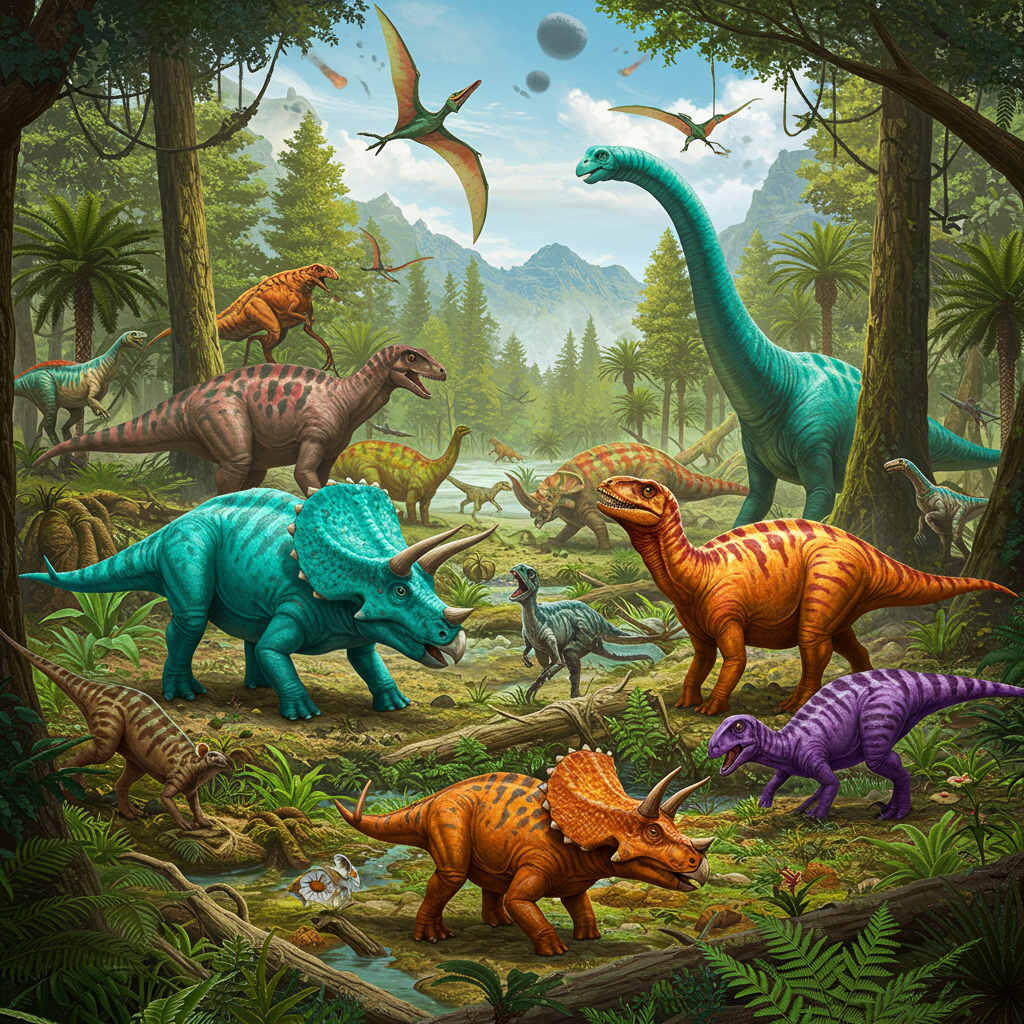For decades, paleontologists have debated a pivotal question: were dinosaurs already fading before the cataclysmic asteroid strike 66 million years ago, or were they flourishing until a sudden, brutal end? New groundbreaking research from a site in New Mexico, published in the journal Science, offers compelling evidence to settle this long-standing mystery. This study reveals that dinosaurs were not in decline but instead boasted diverse, thriving communities right up to the very moment of their extinction, dramatically reshaping our understanding of the end of the Cretaceous Period.
Re-examining the End-Cretaceous Debate
The prevailing theory suggests that a massive asteroid, roughly 6.2 miles wide, slammed into Mexico’s Yucatán Peninsula. This event triggered a global catastrophe, wiping out 75% of Earth’s species. However, some researchers proposed a “gradual decline” hypothesis. This idea suggested that dinosaurs were already struggling. They faced weakened ecosystems before the asteroid delivered the final blow. Answering this complex question demands precisely dated fossils. These fossils must capture life from just before the global extinction event. Such sites are exceptionally rare, making the new findings from New Mexico invaluable.
Unlocking Earth’s Ancient Timeline
The site, located within the Naashoibito Member of the San Juan Basin in northwestern New Mexico, provides a unique window into these final dinosaur days. Dating ancient rock layers is notoriously challenging. Andrew Flynn, lead study author and assistant professor at New Mexico State University, explains the difficulty. Exposed layers are needed for study. Then, the rocks themselves must be dated with precision.
Flynn’s team overcame these hurdles using two advanced dating methods:
Paleomagnetism: Scientists analyzed magnetic particles within the rock. These particles align with Earth’s magnetic field at the time of formation. The end-Cretaceous mass extinction occurred during a brief period of reversed magnetic polarity. This specific alignment helped researchers narrow down the timeline accurately.
Radiometric Dating: The team also measured the decay of specific elements in sand grains found in the sandstone. This technique provides absolute ages for the rock layers.
These meticulous methods revealed that the dinosaur fossils from Naashoibito date to a critical 380,000-year window. This period directly precedes the mass extinction event. This tight timeframe directly contradicts the idea of a prolonged decline. Instead, it paints a picture of robust life just before the impact. Mammals, for instance, appeared about 350,000 years after the dinosaur extinction in the same region, marking a clear biological shift.
A Vibrant Southern Ecosystem Flourishes
For many years, the Hell Creek Formation in Montana, Wyoming, and the Dakotas offered the primary evidence for late-Cretaceous dinosaurs. This northern site revealed species like Triceratops and Edmontosaurus. Yet, it notably lacked any giant, long-necked sauropods. This absence led some paleontologists to believe these colossal creatures had already disappeared.
The new research from New Mexico dramatically changes this view. The Naashoibito Member, dated to the same critical period as Hell Creek, paints a very different picture for southern North America. Here, dinosaurs were flourishing. The south was home to Alamosaurus, one of the largest long-necked dinosaurs ever. These majestic sauropods could reach 100 feet long, stand 30 to 50 feet tall, and weigh over 30 tons. Their presence “up to the very end” is powerful evidence against any pre-impact decline, as study co-author Steve Brusatte from the University of Edinburgh emphasizes.
North vs. South: A Divided Dominion
The study unveiled distinct dinosaur communities across North America. This phenomenon is known as “provinciality.” While some famous dinosaurs, like the formidable Tyrannosaurus rex and the horned Torosaurus, roamed both northern and southern regions, many others were geographically specific.
Northern Climates: Hell Creek, with its cooler conditions and lower elevation, supported abundant duck-billed and horned dinosaurs.
Southern Tropics: The Naashoibito Member boasted a warm, humid, tropical forest-like environment, similar to modern Panama. This lush habitat was ideal for giant sauropods like Alamosaurus and distinctive crested duck-billed dinosaurs.
This regional variation wasn’t due to geographical barriers. Instead, climate was the primary driver. Dinosaurs adapted to their local conditions, carving out diverse niches in the food chain. Brusatte notes that “there is no sign that these dinosaurs were in any trouble.” This underscores their successful adaptation and rich diversity across the continent.
Challenging Old Perceptions
Lead author Andrew Flynn directly challenges the long-held decline theory. He states, “What our new research shows is that dinosaurs are not on their way out going into the mass extinction… They’re doing great, they’re thriving.” He believes the asteroid impact alone was responsible for their sudden demise. This counters the idea that a long-term decline made them more vulnerable.
The perception of declining diversity before the asteroid might stem from observational bias. Flynn suggests that fewer exposed rocks from the very end of the Cretaceous could lead to an inaccurate assessment of overall diversity. Darla Zelenitsky, an associate professor at the University of Calgary, supports the new findings. Her team’s work in Alberta, uncovering diverse fossil eggshells, aligns with the idea of stable dinosaur populations.
Nuance and the Broader Picture
While the new evidence for localized thriving is compelling, some experts offer a broader perspective. Michael Benton, a professor of vertebrate paleontology at the University of Bristol, acknowledges the “very exciting” new evidence. However, he cautions that this is “just one location.” It might not represent the full complexity of dinosaur faunas across all of North America or globally.
Benton points to other research, including some referenced in the Science paper, suggesting a general decline in dinosaur species over the last six million years of the Cretaceous. This data indicates a drop from 43 to 30 species in western North America. He suggests evidence for “overall declines in dinosaurs towards the end of the Cretaceous, with individual rich faunas where climates were favourable.” This highlights the complexity of reconstructing ancient ecosystems. The fossil record is often incomplete, as Dr. Lindsay Zanno of the North Carolina Museum of Natural Sciences noted. Missing chapters can obscure the full story.
Frequently Asked Questions
How did scientists determine dinosaurs were thriving before the asteroid impact?
Scientists determined dinosaurs were thriving by meticulously dating rocks and fossils from the Naashoibito Member in New Mexico. Using advanced techniques like paleomagnetism (analyzing Earth’s ancient magnetic field alignment in rocks) and radiometric dating (measuring element decay in sand grains), they established that a diverse dinosaur ecosystem existed there within a mere 380,000 years of the mass extinction event. This brief timeframe, coupled with the presence of colossal, thriving species like Alamosaurus, directly contradicts the idea of a long-term decline.
What were the differences between northern and southern dinosaur populations just before extinction?
Just before the end-Cretaceous extinction, North America showcased distinct dinosaur communities. Northern regions, like the Hell Creek Formation (Montana, Wyoming, Dakotas), experienced cooler conditions and primarily hosted duck-billed dinosaurs such as Edmontosaurus and horned dinosaurs like Triceratops. In contrast, the warmer, humid, tropical-like southern regions, exemplified by the Naashoibito Member in New Mexico, supported immense long-necked sauropods like Alamosaurus and unique crested duck-bills. Climate, rather than geographical barriers, was the key factor driving these diverse regional populations.
What can the sudden dinosaur extinction teach us about current environmental change?
The sudden and complete extinction of dinosaurs, even thriving species, serves as a powerful cautionary tale for today. The asteroid impact represented an abrupt and catastrophic climate and environmental shift. As co-author Steve Brusatte notes, “Sudden climate and environmental change can catch animals and ecosystems unaware.” This historical event underscores that even the strongest and most iconic species are vulnerable when faced with rapid, drastic alterations to their environment. It highlights the critical need for understanding and addressing contemporary climate change and its potential impacts on Earth’s ecosystems.
A Powerful Lesson from the Past
The new findings from New Mexico offer crucial insights into the incredible resilience and adaptability of dinosaurs. These fascinating creatures were not slowly fading away. They were vibrant and diverse until a single, unforeseen catastrophe brought their 150-million-year reign to an abrupt end. The Alamosaurus shaking the ground one minute, only for the entire Earth to shake with asteroid impact energy the next, paints a stark picture. This research reminds us of the fragility of even the most dominant species. It underscores the profound and lasting impact of sudden climate and environmental change, a lesson as relevant today as it was 66 million years ago.




